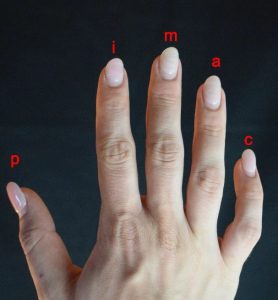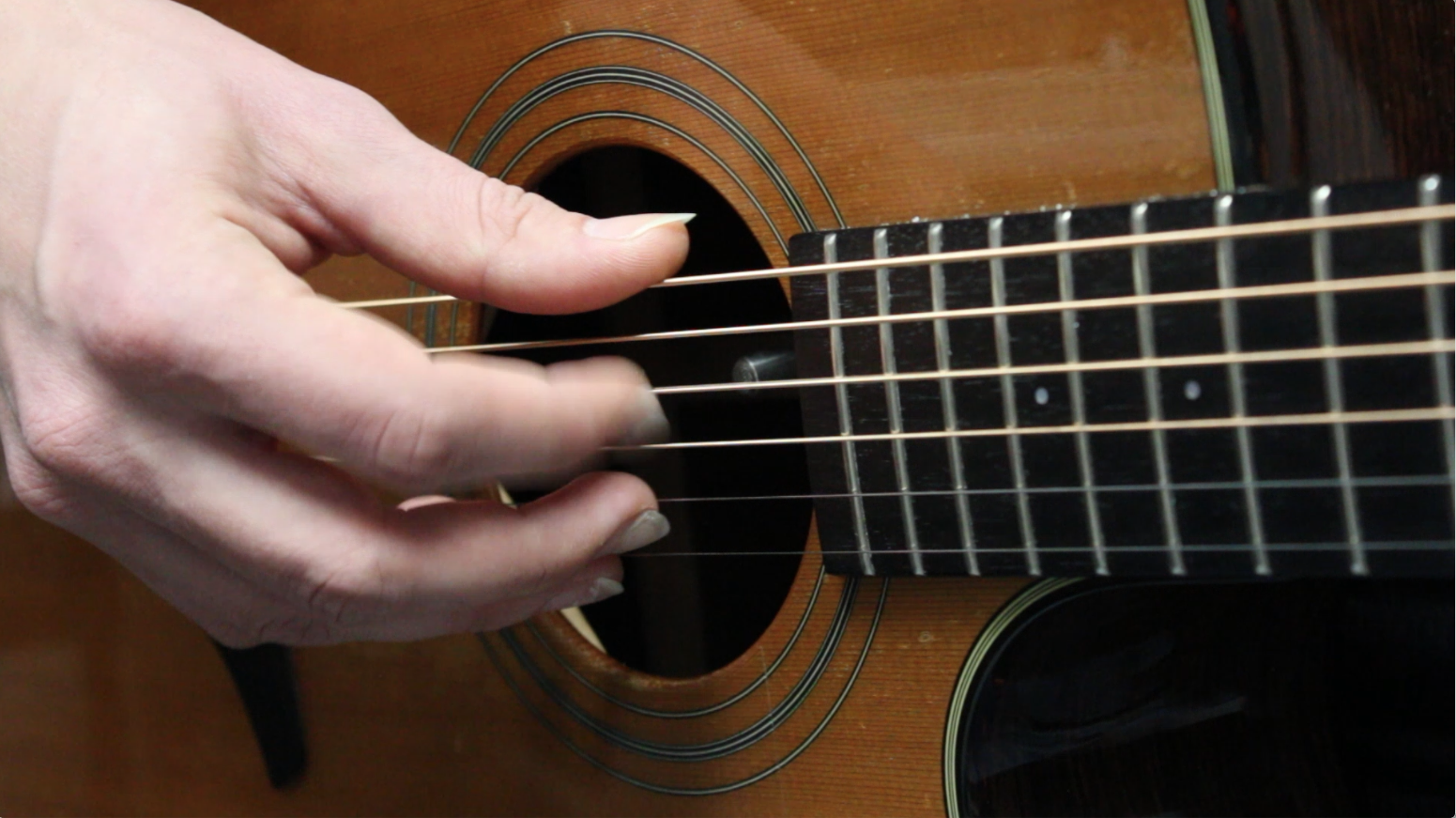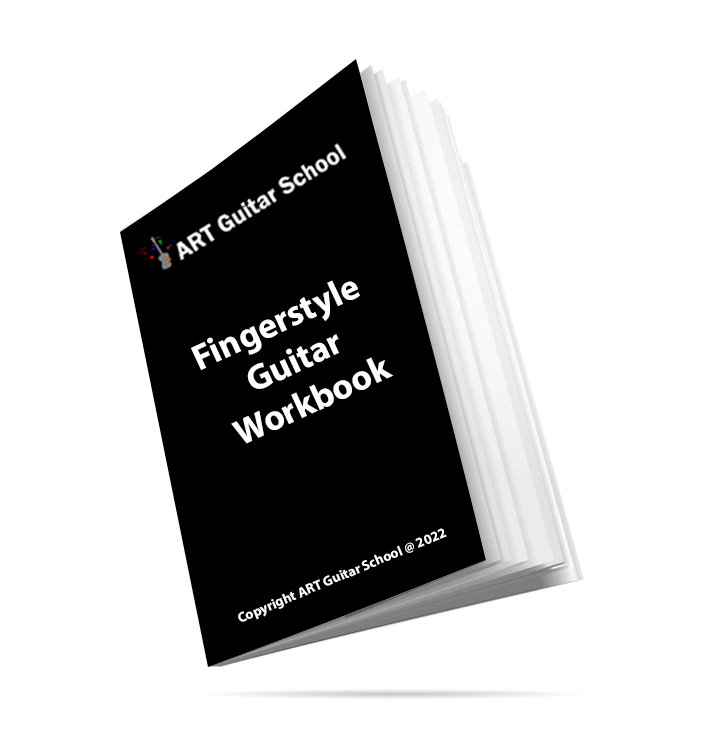FINGERPICKING KEY

The right hand:
P = Thumb
I = Index
M = Middle
A = Ring
Fingerpicking Pattern No. 1
This is the most essential fingerpicking pattern to start with. It requires no left hand chord or fretted notes. It is used in many popular fingerpicking songs and some songs are slight variations of this same pattern.
We have all open strings being plucked in sequential order. Each note is a quarter note in duration and will last exactly one second each if played at 60bpm.
Lets get to playing!
We will pluck each open string in order starting from the 6th string (Low E) and ending on the 1st (High E).
Step 1. Lets start with thumb (p) and pluck the 6th-4th string
Step 2. Pluck index (i), middle (m) and ring (a) on the 3rd-1st strings.

Here is a video demonstration of the finger picking pattern:
If you were having trouble please contact us and we will help you!
FOLLOW US ON
Get our FREE Fingerstyle Workbook!
RELATED BLOG POSTS
Guitar Slap and Pop Techniques
Hey there fellow guitar enthusiasts! Today, let’s dive deep into the electrifying world of slap and pop techniques for guitar. Whether you’re a seasoned player looking to expand your repertoire or a beginner eager to spice up your sound, mastering these techniques can take your playing to the next level.
Slap and pop techniques originated in funk music but have since been adopted across various genres, from rock to jazz to pop. Slapping involves striking the strings with the thumb in a percussive manner, while popping entails pulling the strings away from the fretboard to create a sharp, popping sound. Together, these techniques can add a dynamic rhythmic flair to your playing.
To master slap and pop, start by focusing on your thumb technique. Practice striking the strings with precision and control, experimenting with different rhythms and accents. Next, work on your popping technique, making sure to pull the strings away from the fretboard with enough force to produce a clear, percussive sound.
As you become more comfortable with slap and pop, try incorporating them into your favorite songs and improvisations. Experiment with different techniques and rhythms, and don’t be afraid to push the boundaries of your creativity. With time and dedication, you’ll be slapping and popping like a pro in no time!
So, grab your guitar and get ready to unleash the groove with slap and pop techniques. Whether you’re jamming with friends or performing on stage, these techniques are sure to take your playing to new heights of musical expression. Happy slapping!
Guitar Palm Muting Exercises
Palm muting is a technique that involves lightly resting the edge of your picking hand on the strings near the bridge of the guitar to create a muted, percussive sound. It is commonly used in genres such as metal and punk to add a punchy and aggressive quality to rhythm parts. Mastering palm muting requires practice and control to achieve the desired tight and rhythmic sound.
One effective exercise to improve your palm muting technique is to start with simple power chord patterns. Begin by playing a basic power chord on the low E string, using your picking hand to lightly rest on the strings near the bridge to mute the sound. Practice strumming with a consistent and even pressure to achieve a tight and percussive sound.
As you become more comfortable with palm muting power chords, you can experiment with different rhythms and patterns to create variations in your playing. Practice accenting certain beats and adding syncopated rhythms to enhance the overall groove and feel of your palm-muted playing.
Focus on maintaining a steady and consistent muting technique as you practice different chord progressions and strumming patterns. Pay attention to the amount of pressure you apply with your picking hand to achieve the desired level of muting while still allowing the notes to ring out clearly. By incorporating palm muting exercises into your practice routine, you will improve your rhythm and precision on the guitar, creating a dynamic and powerful sound in your playing.
Guitar String Skipping Techniques
String skipping is a technique that involves jumping over strings to create unique and intricate sounds on the guitar. It is commonly used in genres such as rock and metal to add complexity and interest to solos and riffs. Mastering string skipping techniques requires practice and precision, as it involves precise coordination between your pick strokes and fretting hand movements.
One effective exercise to improve your string skipping skills is to start with simple two-string patterns. Begin by placing your fretting hand on the 5th fret of the low E string and play the following pattern: E5, D7, G5. Use a combination of alternate picking and legato techniques to skip over the A string while maintaining a smooth and even rhythm.
As you become more comfortable with two-string patterns, you can gradually increase the complexity of the exercises by incorporating larger intervals and string skips. Experiment with different scales and arpeggios to create unique and challenging string skipping patterns that will enhance your overall guitar playing.
Focus on developing clean and precise movements with both your picking hand and fretting hand to ensure a smooth transition between strings. Practice slowly and gradually increase your speed as you build confidence with the technique. By incorporating string skipping exercises into your practice routine, you will improve your dexterity and coordination on the guitar, opening up new creative avenues for your playing.




0 Comments